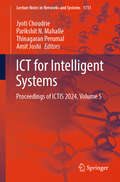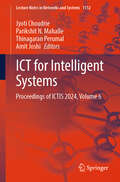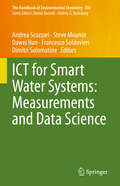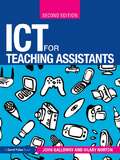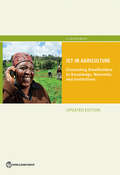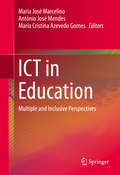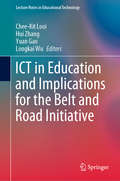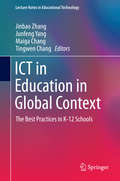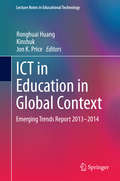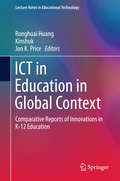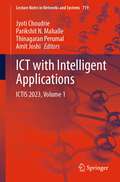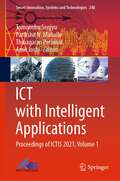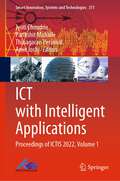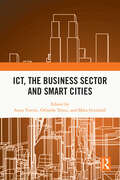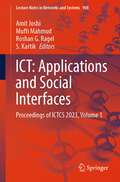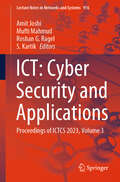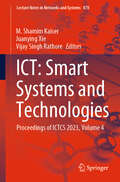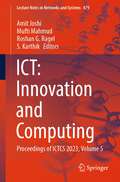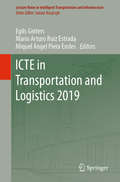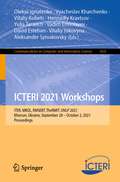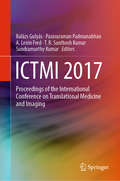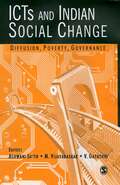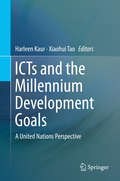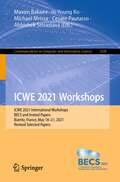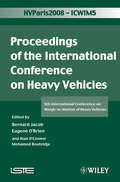- Table View
- List View
ICT for Intelligent Systems: Proceedings of ICTIS 2024, Volume 5 (Lecture Notes in Networks and Systems #1111)
by Amit Joshi Jyoti Choudrie Parikshit N. Mahalle Thinagaran PerumalThis book gathers papers addressing state-of-the-art research in all areas of information and communication technologies and their applications in intelligent computing, cloud storage, data mining, and software analysis. It presents the outcomes of the 8th International Conference on Information and Communication Technology for Intelligent Systems (ICTIS 2024), held in Ahmedabad, India. The book is divided into six volumes. It discusses the fundamentals of various data analysis techniques and algorithms, making it a valuable resource for researchers and practitioners alike.
ICT for Intelligent Systems: Proceedings of ICTIS 2024, Volume 6 (Lecture Notes in Networks and Systems #1112)
by Amit Joshi Jyoti Choudrie Parikshit N. Mahalle Thinagaran PerumalThis book gathers papers addressing state-of-the-art research in all areas of information and communication technologies and their applications in intelligent computing, cloud storage, data mining, and software analysis. It presents the outcomes of the 8th International Conference on Information and Communication Technology for Intelligent Systems (ICTIS 2024), held in Ahmedabad, India. The book is divided into six volumes. It discusses the fundamentals of various data analysis techniques and algorithms, making it a valuable resource for researchers and practitioners alike.
ICT for Smart Water Systems: Measurements and Data Science (The Handbook of Environmental Chemistry #102)
by Andrea Scozzari Francesco Soldovieri Dawei Han Steve Mounce Dimitri SolomatineToday, Information and Communication Technologies (ICT) have a pervasive presence in almost every aspect of the management of water. There is no question that the collection of big data from sensing and the insights gained by smart analytics can bring massive benefits. This book focuses on new perspectives for the monitoring, assessment and control of water systems, based on tools and concepts originating from the ICT sector. It presents a portrait of up-to-date sensing techniques for water, and introduces concepts and implications with the analysis of the acquired data. Particular attention is given to the advancements in developing novel devices and data processing approaches. The chapters guide the reader through multiple disciplinary contexts, without aiming to be exhaustive, but with the effort to present relevant topics in such a highly multi-disciplinary framework. This book will be of interest to advanced students, researchers and stakeholders at various levels.
ICT for Teaching Assistants
by John Galloway Hilary NortonThe role of ICT in enhancing both teaching and learning in classrooms continues to develop, no more so than when in the hands of effective practitioners. This easy-to-use book outlines the many ways in which it can be used, both as a subject, and as a tool to support learning across the curriculum. Now fully updated to take into account innovations in ICT and the revised National Occupational Standards, ICT for Teaching Assistants looks at the impact of these changes and includes: Practical examples of how ICT, including web-based tools such as ‘blogs’ and ‘wikis’, can be used; Guidance to working competently and safely on the internet; Suggestions for activities with ideas for how these can be used in a variety of contexts; Advice on gathering evidence to help build assessment plans Information on health and safety and legal requirements. With links throughout to the National Occupational Standards for Teaching Assistants at Levels 2 and 3, this accessible book is essential for teaching assistants who wish to develop their confidence in ICT.
ICT in Agriculture (Updated Edition): Connecting Smallholders to Knowledge, Networks, and Institutions
by World BankInformation and communication technology (ICT) has always mattered in agriculture. Ever since people have grown crops, raised livestock, and caught fish, they have sought information from one another. Today, ICT represents a tremendous opportunity for rural populations to improve productivity, to enhance food and nutrition security, to access markets, and to find employment opportunities in a revitalized sector. ICT has unleashed incredible potential to improve agriculture, and it has found a foothold even in poor smallholder farms. ICT in Agriculture, Updated Edition is the revised version of the popular ICT in Agriculture e-Sourcebook, first launched in 2011 and designed to support practitioners, decision makers, and development partners who work at the intersection of ICT and agriculture. Our hope is that this updated Sourcebook will be a practical guide to understanding current trends, implementing appropriate interventions, and evaluating the impact of ICT interventions in agricultural programs.
ICT in Education
by Maria José Marcelino Antonió José Mendes Maria Cristina Azevedo GomesThis book presents a peer reviewed selection of extended versions of ten original papers that were presented at the 15th International Symposium on Computers in Education (SIIE 2013) held in Viseu, Portugal. The book provide a representative view of current Information and Communications Technology (ICT) educational research approaches in the Ibero-American context as well as internationally. It includes studies that range from elementary to higher education, from traditional to distance learning settings. It considers special needs and other inclusive issues, across a range of disciplines, using multiple and diverse perspectives and technologies to furnish detailed information on the latest trends in ICT and education globally. Design, development and evaluation of educational software; ICT use and evaluation methodologies; social web and collaborative systems; and learning communities are some of the topics covered.
ICT in Education and Implications for the Belt and Road Initiative (Lecture Notes in Educational Technology)
by Yuan Gao Chee-Kit Looi Hui Zhang Longkai WuWith increasing global challenges, the Belt and Road initiative seems to offer one possible platform to think about different possibilities and pathways to promote international collaboration and development covering Asia, Europe, Africa, and other countries. Information and Communication Technology (ICT) in education, as a key focus, provides valuable perspectives for governments, inter-governmental and non-governmental agencies wanting to innovate and advance both ICT and education independently and collaboratively. This book highlights the burgeoning of ICT in education in eleven countries, with particular emphasis placed on the context of the Belt and Road Initiative. ICT has increasingly important roles in education including improve teaching and learning qualities, as well as equity in education. The prominent contributors describe the state-of-the-art of ICT in education in eleven countries based on six major themes (policy perspectives, infrastructure, educational resources, ICT integration into practices, students’ ICT competence, and teachers’ professional development). We hope the in-depth discussions included in this book would provoke more academic and policy insights globally.
ICT in Education in Global Context
by Maiga Chang Jinbao Zhang Junfeng Yang Tingwen ChangIntended to promote the innovative use of technology in education and promote educational advances all over the world, this volume brings together 16 best-practice cases on technology-enhanced educational innovations. Experts from Turkey, Tunisia, Cyprus, Italy, Malaysia, China, India and Finland have contributed to these cases, highlighting the current state-of-the-art in the use of technology in education in their respective counties. Topics include best practices for designing smart classrooms, effective use of tablets and interactive whiteboards, virtual learning environments, digital learning spaces, game-based learning, synchronous cyber classrooms, micro-courses, among others. The book offers an essential resource on emerging technologies and the educational approaches currently being pursued in different countries to foster effective learning.
ICT in Education in Global Context
by Kinshuk Ronghuai Huang Jon K. PriceThis book aims to capture the current innovation and emerging trends of digital technologies for learning and education in k-12 sector through a number of invited chapters in key research areas. Emerging Patterns of innovative instruction in different context, Learning design for digital natives, Digital learning resources for personalized learning in both formal and informal educational settings, e-leadership and teacher's digital capacity will be covered in the book. This book intends to provide reference for the innovation in K-12 schools. Researchers, policy makers, school administrators and also teachers could benefit from this book on researchers and methods for innovation in K-12 schools all over the world.
ICT in Education in Global Context
by Kinshuk Ronghuai Huang Jon K. PriceThis book aims to capture the current innovation and emerging trends of digital technologies for learning and education in k-12 sector through a number of invited chapters in key research areas. Emerging Patterns of innovative instruction in different context, Learning design for digital natives, Digital learning resources for personalized learning in both formal and informal educational settings, e-leadership and teacher's digital capacity will be covered in the book. This book intends to provide reference for the innovation in K-12 schools. Researchers, policy makers, school administrators and also teachers could benefit from this book on researchers and methods for innovation in K-12 schools all over the world.
ICT with Intelligent Applications: ICTIS 2023, Volume 1 (Lecture Notes in Networks and Systems #719)
by Amit Joshi Jyoti Choudrie Parikshit N. Mahalle Thinagaran PerumalThis book gathers papers addressing state-of-the-art research in all areas of information and communication technologies and their applications in intelligent computing, cloud storage, data mining, and software analysis. It presents the outcomes of the Seventh International Conference on Information and Communication Technology for Intelligent Systems (ICTIS 2023), held in Ahmedabad, India. The book is divided into two volumes. It discusses the fundamentals of various data analysis techniques and algorithms, making it a valuable resource for researchers and practitioners alike.
ICT with Intelligent Applications: Proceedings of ICTIS 2021, Volume 1 (Smart Innovation, Systems and Technologies #248)
by Amit Joshi Parikshit N. Mahalle Tomonobu Senjyu Thinagaran PerumalThis book gathers papers addressing state-of-the-art research in all areas of information and communication technologies and their applications in intelligent computing, cloud storage, data mining and software analysis. It presents the outcomes of the Fifth International Conference on Information and Communication Technology for Intelligent Systems (ICTIS 2021), held in Ahmedabad, India. The book is divided into two volumes. It discusses the fundamentals of various data analysis techniques and algorithms, making it a valuable resource for researchers and practitioners alike.
ICT with Intelligent Applications: Proceedings of ICTIS 2022, Volume 1 (Smart Innovation, Systems and Technologies #311)
by Amit Joshi Jyoti Choudrie Parikshit Mahalle Thinagaran PerumalThis book gathers papers addressing state-of-the-art research in all areas of information and communication technologies and their applications in intelligent computing, cloud storage, data mining and software analysis. It presents the outcomes of the Sixth International Conference on Information and Communication Technology for Intelligent Systems (ICTIS 2022), held in Ahmedabad, India. The book is divided into two volumes. It discusses the fundamentals of various data analysis techniques and algorithms, making it a valuable resource for researchers and practitioners alike.
ICT, the Business Sector and Smart Cities
by Anna Visvizi Orlando Troisi Mara GrimaldiThis book examines smart cities through the lens of the information and communication technology (ICT)-driven transformation of the economy and economic systems and the resulting changes influencing organizations (public, private, and voluntary) and citizens in the smart city. In this context, the chapters included in this book address very specific questions pertaining to modes and models of economic collaboration, interest aggregation, and determinants of sustainable growth and development in the smart city. To this end, the circular economy, the sharing economy, the platform economy, and open innovation in the smart city are discussed. The notions of economic performance, competition, and business model innovation (BMI) are elaborated in detail. Finally, the question of the fragility of labor markets, including the availability of talent, is explored. By applying conceptually sound, inter- and multi-disciplinary approaches, frequently including case studies, this book provides a thorough insight into the complex question of how tools specific to the fields of economics, business management, innovation management, strategic management, entrepreneurship, and human resource management can be useful in view of understanding and harnessing the intrusion of ICT in the city space.
ICT: Proceedings of ICTCS 2023, Volume 1 (Lecture Notes in Networks and Systems #908)
by Amit Joshi Mufti Mahmud Roshan G. Ragel S. KartikThis book contains best selected research papers presented at ICTCS 2023: Eighth International Conference on Information and Communication Technology for Competitive Strategies. The conference will be held in Jaipur, India during 8 – 9 December 2023. The book covers state-of-the-art as well as emerging topics pertaining to ICT and effective strategies for its implementation for engineering and managerial applications. This book contains papers mainly focused on ICT for computation, algorithms and data analytics and IT security. The work is presented in five volumes
ICT: Proceedings of ICTCS 2023, Volume 3 (Lecture Notes in Networks and Systems #916)
by Amit Joshi Mufti Mahmud Roshan G. Ragel S. KartikThis book contains best selected research papers presented at ICTCS 2023: Eighth International Conference on Information and Communication Technology for Competitive Strategies. The conference will be held in Jaipur, India during 8 – 9 December 2023. The book covers state-of-the-art as well as emerging topics pertaining to ICT and effective strategies for its implementation for engineering and managerial applications. This book contains papers mainly focused on ICT for computation, algorithms and data analytics and IT security. The work is presented in three volumes.
ICT: Proceedings of ICTCS 2023, Volume 4 (Lecture Notes in Networks and Systems #878)
by Vijay Singh Rathore M. Shamim Kaiser Juanying XieThis book contains best selected research papers presented at ICTCS 2023: Eighth International Conference on Information and Communication Technology for Competitive Strategies. The conference will be held in Jaipur, India during 8 – 9 December 2023. The book covers state-of-the-art as well as emerging topics pertaining to ICT and effective strategies for its implementation for engineering and managerial applications. This book contains papers mainly focused on ICT for computation, algorithms and data analytics and IT security. The work is presented in five volumes.
ICT: Proceedings of ICTCS 2023, Volume 5 (Lecture Notes in Networks and Systems #879)
by Amit Joshi Mufti Mahmud Roshan G. Ragel S. KarthikThis book contains best selected research papers presented at ICTCS 2023: Eighth International Conference on Information and Communication Technology for Competitive Strategies. The conference will be held in Jaipur, India during 8 – 9 December 2023. The book covers state-of-the-art as well as emerging topics pertaining to ICT and effective strategies for its implementation for engineering and managerial applications. This book contains papers mainly focused on ICT for computation, algorithms and data analytics and IT security. The work is presented in five volumes.
ICTE in Transportation and Logistics 2019 (Lecture Notes in Intelligent Transportation and Infrastructure)
by Egils Ginters Mario Arturo Ruiz Estrada Miquel Angel Piera ErolesThis proceedings volume explores the latest advances in transport and logistics, while also discussing the applications of modern information technologies, telecommunications, electronics, and prospective research methods and analyzing their impacts on society and the environment, which in turn determine the future development of these technologies. The book is intended for a broad readership, including transport and logistics business planners and technical experts, leveraging industry knowledge and facilitating technology adoption in promising business regions and transit corridors such as Ukraine, Kazakhstan, and others. The authors, who include policy planners and crafters as well as education and training professionals, address various types of intermodal transport such as rail, road, maritime, air, etc.
ICTERI 2021 Workshops: ITER, MROL, RMSEBT, TheRMIT, UNLP 2021, Kherson, Ukraine, September 28–October 2, 2021, Proceedings (Communications in Computer and Information Science #1635)
by Vitaliy Yakovyna Aleksander Spivakovsky Vadim Ermolayev Vyacheslav Kharchenko Oleksii Ignatenko Vitaliy Kobets Hennadiy Kravtsov Yulia Tarasich David EstebanThis book contains the workshops papers presented at the 17th International Conference on Information and Communication Technologies in Education, Research, and Industrial Applications, ICTERI 2021, held in Kherson, Ukraine, in September-October 2021. The 33 revised full papers and 4 short papers included in this volume were carefully reviewed and selected from 105 initial submissions. The papers are organized according to the following workshops: 9th International Workshop on Information Technology in Economic Research (ITER 2021); 5th International Workshop on Methods, Resources and Technologies for Open Learning and Research (MROL 2021); International Workshop RMSEBT 2021: Rigorous Methods in Software Engineering and Blockchain Technologies; 7th International Workshop on Theory of Reliability and Markov Modeling for Information Technologies (TheRMIT 2021); 1st Ukrainian Natural Language Processing Workshop (UNLP 2021).
ICTMI 2017: Proceedings of the International Conference on Translational Medicine and Imaging
by Parasuraman Padmanabhan Balázs Gulyás A. Lenin Fred T. R. Kumar Sundramurthy KumarThis book highlights the latest research presented at the International Conference on Translational Medicine and Imaging (ICTMI) 2017. This event brought together the world’s leading scientists, engineers and clinicians from a wide range of disciplines in the field of medical imaging. Bioimaging has continued to evolve across a wide spectrum of applications from diagnostics and personalized therapy to the mechanistic understanding of biological processes, and as a result there is ever-increasing demand for more robust methods and their integration with clinical and molecular data. This book presents a number of these methods.
ICTs and Indian Social Change: Diffusion, Poverty, Governance
by Ashwani Saith M. Vijayabaskar V. GayathriICTs and Indian Social Change: Diffusion, Poverty, Governance is the first book of its kind that puts together the optimistic voices of techno-idealists, critical social science perspectives on technology and a range of empirical material on the impact of Information and Communication Technologies (ICTs) on the lives of people. The book traces these processes across urban and rural spaces of work, consumption, e-governance, and highlights the new kinds of social identities they are fostering in India. It opens up an arena for dialogue between activists, technologists, policy makers and academia on using ICTs for development. The book is a logical sequel to ICTs and Indian Economic Change: Economy, Work, Regulation that addressed the implications of the growth of ICT-based sectors in India for macro-economic development and industrial efficiency. This volume views the diffusion of ICTs in India primarily in the socio cultural realm. In responding to the pioneering voices of innovators in ICTs, it provides empirical and theoretical assessments and critiques of some of the important though often latent, premises that underlie these powerful initiatives.
ICTs and the Millennium Development Goals
by Harleen Kaur Xiaohui TaoThis book attempts to create awareness about the UN-MDGs and how various ICT can be harnessed to appeal to different demographics. Current empirical evidence suggests that MDG awareness is relatively low particularly in developed countries, and that the levels of MDG awareness vary considerable across socioeconomic variables or demographics from United Nations perspective. It also examines how ICT can be used to bring about technical and social innovations strengthen livelihoods, support economic development, water and climate resilience and improve the education and health sectors and enhance development opportunities. Several studies are highlighted that reinforce the view that government support and private sector expertise and funding are important factors in ICT-based e-government solutions in developing countries. The book also builds on the thesis that a strong connection between competencies in mathematics, science, and information communication/technology is required to build logical concepts and critical thinking skills. It also examines the opportunities and barriers of promoting students' learning skills, including communication, cooperation, collaboration and connection using the Wiki tool under the blackboard platform. Finally, the book also highlights the challenges involved in application of ICT in education. This is significant for educators in order to surmount these obstacles and consequently successfully incorporate ICT into the educational system. The chapters present the relevant literature on ICTs and the perceived barriers to ICT integration in basic education. They also focus on the implications of incorporating ICT in the basic educational system. The challenges confronting the integration of ICT in education are equally identified with a view to ensuring a more efficient application of ICT in attaining education for all.
ICWE 2021 Workshops: ICWE 2021 International Workshops, BECS and Invited Papers, Biarritz, France, May 18–21, 2021, Revised Selected Papers (Communications in Computer and Information Science #1508)
by Cesare Pautasso Michael Mrissa Maxim Bakaev In-Young Ko Abhishek SrivastavaThis book constitutes the thoroughly refereed post-workshop proceedings of the 21th International Conference on Web Engineering, ICWE 2021, held in Biarritz, France, in May 2021.*The first international workshop on Big data-driven Edge Cloud Services (BECS 2021) was held to provide a venue in which scholars and practitioners can share their experiences and present on-going work on providing value-added Web services for users by utilizing big data in edge cloud environments. The 5 revised full papers and 1 revised short contribution selected from 11 submissions are presented with 2 invited papers.*The conference was held virtually due to the COVID-19 pandemic.
ICWIM 5, Proceedings of the International Conference on Heavy Vehicles: 5th International Conference on Weigh-in-Motion of Heavy Vehicles
by Mohamed Bouteldja Bernard Jacob Alan O’Connor Eugene O’BrienWeigh-in-motion (WIM) is a process of measuring the dynamic tire forces of a moving vehicle and estimating the corresponding tire loads of the static vehicle. This collection of lectures from the International Conference on Weigh-in-Motion details applications such as: collection of statistical traffic data, support of commercial vehicle enforcement, roadway and bridge cost allocation, and traffic management.
